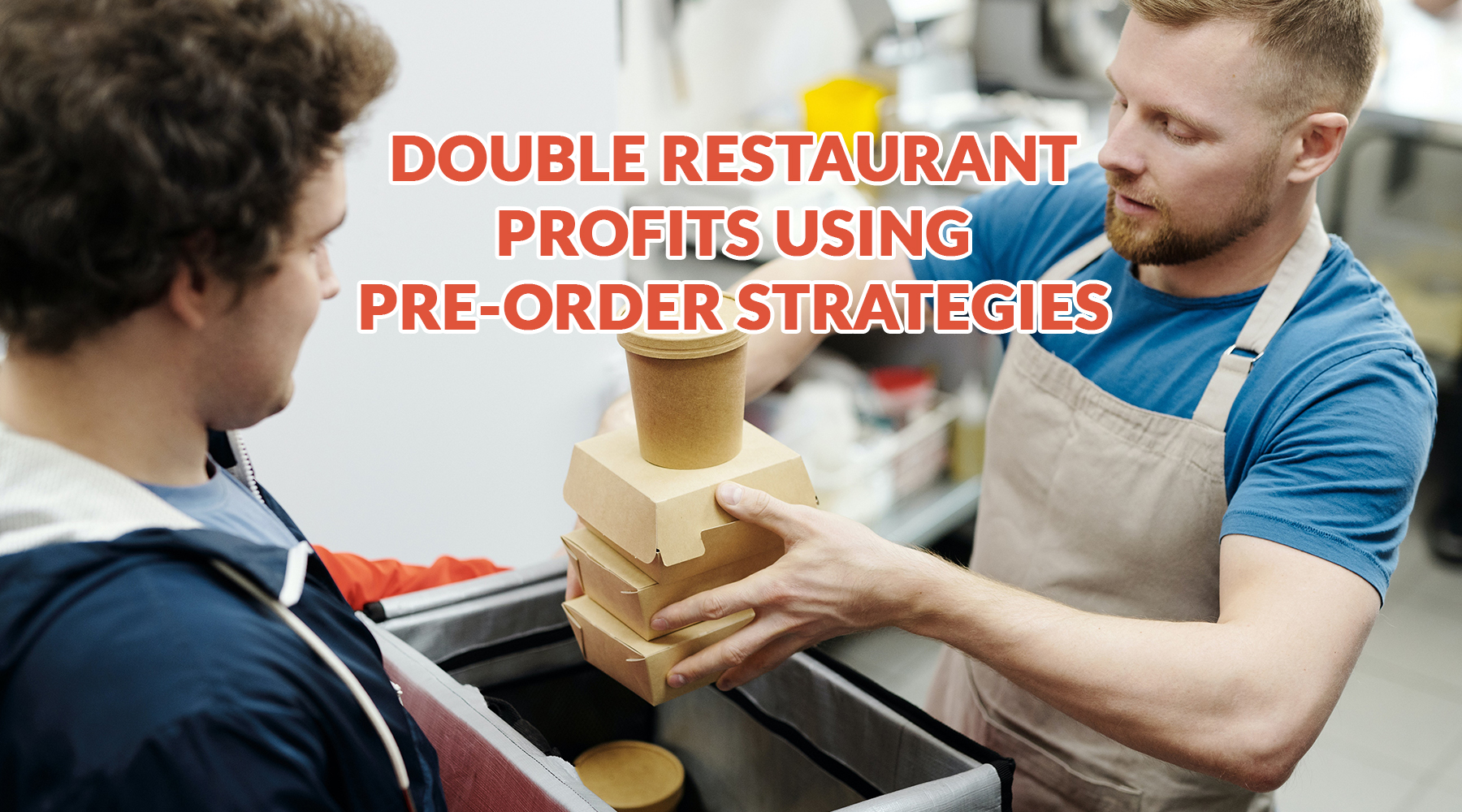
In the highly competitive and ever-evolving restaurant industry, businesses are constantly seeking innovative strategies to enhance their profitability and gain a competitive edge. One such strategy that has gained significant traction in recent years is the utilization of pre-order systems. These systems allow customers to place their orders in advance, enabling restaurants to optimize their operations, streamline order processing, and gather valuable insights into customer preferences. The implementation of pre-order strategies has the potential to revolutionize the way restaurants operate, ultimately leading to substantial increases in profits and overall success.
This article aims to provide a comprehensive understanding of the benefits associated with pre-order strategies, exploring their impact on various aspects of restaurant operations, such as seating capacity, order efficiency, customer satisfaction, and food waste reduction. By incorporating data-driven insights and leveraging cutting-edge tools and platforms, such as Strikingly and Tripleseat, restaurants can develop effective pre-order campaigns and marketing strategies that cater to the needs of their tech-savvy clientele. Additionally, the article will offer practical tips and best practices for implementing pre-order systems, enabling restaurant owners and managers to harness their potential and achieve significant improvements in profitability and growth.
Optimize Seating Capacity for Enhanced Restaurant Success
Effectively maximizing seating capacity plays a crucial role in ensuring the overall success of a dining establishment. Optimizing the use of available space not only increases the number of patrons served but also contributes to a more efficient and profitable business operation. To achieve this, restaurateurs should develop a strategic floor plan that accommodates various group sizes, minimizes wait times, and promotes a comfortable dining experience. This approach not only enhances customer satisfaction but also encourages repeat patronage and positive word-of-mouth marketing, ultimately leading to increased revenue.
Several factors should be taken into consideration when optimizing seating capacity. First, the type of establishment and target clientele will significantly impact the desired layout and seating arrangements. For instance, a family-oriented restaurant may prioritize larger tables for group dining, while a fine dining establishment may focus on smaller, more intimate settings. Additionally, the balance between maximizing capacity and maintaining an aesthetically pleasing and inviting atmosphere should be carefully considered, as overcrowding may negatively impact the customer experience and discourage future visits.
One effective strategy for maximizing seating capacity and revenue is the implementation of a pre-order system. By allowing patrons to place orders in advance, restaurants can better manage inventory, reduce food waste, and streamline kitchen operations. This, in turn, accelerates the overall dining process and enables establishments to serve more customers within a given timeframe. Moreover, pre-orders can help reduce wait times and enhance the overall customer experience, as patrons can enjoy their meals without the frustration of long waits or sold-out items.
By successfully optimizing seating capacity and incorporating pre-order strategies, restaurants can significantly improve their overall operational efficiency and, ultimately, increase profits. As the establishment continues to refine its processes and layout, it is crucial to remain adaptable and responsive to evolving customer needs and preferences. With these considerations in mind, the next step for a thriving restaurant business is to enhance order processing for efficiency, further contributing to a seamless and profitable dining experience.
Enhance Restaurant Order Processing for Efficiency
Enhancing the efficiency of restaurant order processing can lead to streamlined operations, increased customer satisfaction, and ultimately, higher profit margins. One way to achieve this is by implementing pre-order strategies, which allow customers to order their meals in advance, reducing wait times and ensuring that their desired menu items are available. This approach can also help restaurants better manage their inventory and staffing needs, as they can anticipate customer demand and make informed decisions regarding resource allocation.
Another aspect of improving order processing efficiency is integrating technology into the system. Utilizing mobile applications, websites, and online ordering platforms allows customers to conveniently place their orders from anywhere, at any time. This not only benefits the customers but also helps the restaurant staff in managing orders, reducing errors, and minimizing miscommunication. Additionally, incorporating digital payment options and mobile point of sale (POS) devices can expedite the payment process and enhance the overall dining experience.
Offering a well-organized, user-friendly menu can also contribute to enhanced order processing efficiency. Clear and concise menu descriptions, accurate pricing, and visually appealing design elements can facilitate the decision-making process for customers, leading to quicker order placements. Moreover, offering tailored menu options, such as pre-set meal packages or personalized dishes, can cater to the diverse needs and preferences of customers, ultimately increasing their satisfaction and promoting repeat visits.
By employing these strategies, restaurants can optimize their order processing systems, leading to increased operational efficiency and higher profit margins. As a result, customers will enjoy a seamless dining experience, characterized by reduced wait times and personalized service. This positive experience will contribute to boosting client happiness and loyalty, paving the way for sustained success and growth in the competitive restaurant industry.
Boosting Client Happiness and Loyalty
Boosting client happiness and loyalty can be achieved by implementing innovative pre-order strategies, which not only streamline restaurant operations but also create a seamless and personalized dining experience for customers. For instance, by allowing customers to place and customize their orders in advance, restaurants can ensure that they have adequate preparation time to cater to unique dietary preferences and requirements, resulting in satisfied customers who are more likely to return. Additionally, pre-ordering enables restaurants to manage their inventory more effectively, reducing food wastage and ensuring that dishes are prepared with the freshest ingredients. This not only optimizes the overall dining experience but also reflects positively on the restaurant’s commitment to sustainability and quality.
One effective method to encourage customers to use pre-order services is by offering exclusive incentives, such as discounts, loyalty points, or priority seating. These perks can be promoted through social media, email newsletters, and in-house marketing materials, targeting both new and existing customers. By combining these incentives with personalized recommendations based on customers’ previous orders and preferences, restaurants can significantly enhance their client satisfaction levels and foster long-lasting relationships.
Furthermore, collecting and analyzing data from pre-orders can provide valuable insights into customer preferences, enabling restaurants to curate tailored menus and promotions that cater to the evolving tastes of their clientele. This data-driven approach not only helps in fine-tuning the restaurant’s offerings but also assists in identifying potential areas of improvement in terms of service, ambiance, and overall customer experience. Consequently, restaurants can make informed decisions to enhance their operations and exceed customer expectations, thereby strengthening brand loyalty.
By incorporating pre-order strategies and leveraging the benefits they offer, restaurants can effectively boost client happiness and loyalty, ensuring a steady flow of repeat customers and positive word-of-mouth referrals. The next step in optimizing restaurant operations and maximizing profits is to expand restaurant services with curbside pickups and deliveries, capitalizing on the increasing demand for convenient and contactless dining options.
Expand Restaurant Services with Curbside Pickups & Deliveries
Expanding restaurant services to include curbside pickups and deliveries can significantly contribute to increased revenue, as it caters to the growing consumer preference for convenient and contactless dining options. By offering these services, restaurants can tap into a market of busy professionals, families, and individuals who prefer to enjoy their meals at home or on the go. Furthermore, this strategy allows restaurants to serve more customers during peak hours without the need for additional seating capacity or staff, ultimately maximizing profits and minimizing operational costs.
In addition to the financial benefits, curbside pickups and deliveries can enhance customer satisfaction by providing a fast, efficient, and personalized dining experience. By implementing user-friendly online ordering systems and mobile applications, restaurants can streamline the ordering process, allowing customers to customize their orders, track delivery progress, and receive notifications about special promotions or loyalty rewards. This seamless integration of technology not only improves operational efficiency but also fosters a sense of connection between the restaurant and its customers.
Moreover, data-driven insights gathered from online orders and delivery services can help restaurant owners make informed decisions about menu offerings, pricing strategies, and marketing campaigns. By analyzing customer preferences, order frequency, and popular menu items, restaurants can better tailor their services to meet the needs and desires of their target audience. This data-driven approach can ultimately lead to higher customer retention rates and increased brand loyalty, further contributing to overall business growth.
Expanding restaurant services with curbside pickups and deliveries is a strategic move that benefits both the restaurant and its customers. As restaurants continue to adapt to the evolving preferences of their patrons, offering convenient and contactless dining options will not only increase revenue and customer satisfaction but also attract a growing number of tech-savvy customers who value efficiency and convenience in their dining experiences.
Attract a growing number of tech-savvy customers.
Catering to the preferences of an increasingly tech-savvy clientele, restaurants can significantly elevate their revenue by implementing innovative pre-order strategies that streamline the dining experience and foster customer loyalty. By offering pre-order options through digital platforms, restaurants can enhance convenience for customers, enabling them to plan their meals in advance and minimize wait times. As a result, patrons are more likely to return to establishments that prioritize their needs and provide a seamless experience.
- Implement user-friendly online platforms: To attract tech-savvy customers, restaurants must ensure that their pre-order systems are intuitive and accessible across various devices. This includes optimizing websites for mobile use, offering mobile apps, and integrating with popular third-party ordering services.
- Utilize social media and targeted marketing: Engaging with customers on social media platforms can significantly boost a restaurant’s online presence, leading to increased pre-order sales. By targeting specific demographics, restaurants can tailor their marketing efforts and create personalized promotions to drive pre-order sales.
- Offer exclusive incentives for pre-ordering: Incentivizing customers to pre-order through exclusive offers, discounts, or limited edition menu items can encourage repeat business and drive customer loyalty. These initiatives can be promoted through email marketing, social media, and in-restaurant advertising.
By addressing the needs of tech-savvy customers and implementing pre-order strategies, restaurants can achieve a competitive edge in the market and foster long-term growth. Additionally, these strategies can improve operational efficiency, allowing establishments to manage inventory more effectively and ensure customer satisfaction. With a strong focus on innovation and customer-centric solutions, restaurants can successfully navigate the changing landscape of the industry and leverage customer data for restaurant success.
Leverage Customer Data for Restaurant Success
As the restaurant industry evolves and embraces technology, it is essential to understand and leverage customer data to gain a competitive edge. By analyzing customer preferences, spending habits, and dining patterns, it becomes possible to create personalized experiences and targeted promotions, ultimately driving customer satisfaction and increasing profits. This data-driven approach allows establishments to cater to the unique needs of their clientele, ensuring that they remain at the forefront of the industry.
One way to leverage customer data for restaurant success is by implementing a data-driven menu design. By analyzing sales data and customer feedback, restaurateurs can identify high-performing dishes and strategically place them on the menu to maximize profits. Additionally, this information can be used to make informed decisions about new menu items, enabling restaurants to stay ahead of trends and continuously evolve their offerings. Furthermore, understanding customer preferences can help in creating targeted marketing campaigns, which are more likely to resonate with the audience and lead to increased sales.
Customer data can also be utilized to enhance the overall dining experience, leading to increased customer loyalty and repeat business. For instance, by analyzing data on customer preferences, restaurants can tailor their service and ambiance to cater to specific demographics or occasions, such as romantic dinners or family gatherings. Additionally, this data can be used to optimize staffing levels, ensuring that restaurants have the right number of staff members on hand to provide excellent service during peak hours.
Incorporating customer data into restaurant operations not only allows for more informed decision-making but also helps in identifying areas where improvements can be made, ultimately leading to increased profits. By continuously analyzing and acting on this valuable information, restaurateurs can better understand their customers, adapt to their needs, and stay ahead of the competition. This data-driven approach will prove essential in minimizing restaurant food waste and maximizing profitability in the long run.
Minimize Restaurant Food Waste for Increased Profitability
Minimizing food waste in the restaurant industry is crucial for enhancing profitability, with a staggering 40% of food in the United States going uneaten, leading to both financial and environmental repercussions. By implementing effective pre-order strategies, restaurants can significantly reduce the amount of food waste generated, which allows them to save on costs and contribute to a greener environment. Pre-order strategies enable restaurants to plan their inventory and production more accurately, ensuring that they only prepare the necessary amount of food based on confirmed customer orders.
One effective pre-order strategy is to offer limited-time promotions or themed menus that customers can only order in advance. This approach not only creates a sense of urgency and exclusivity but also enables the establishment to gauge the demand for specific menu items and adjust their procurement and production accordingly. Additionally, by incentivizing customers to place pre-orders through discounts or other perks, restaurants can further drive the adoption of this waste-reducing practice.
Another way to minimize food waste is by leveraging data and analytics to optimize menu offerings and portion sizes. By analyzing historical sales data and customer feedback, restaurant owners can identify which dishes are most popular and adjust their menu offerings accordingly. This enables them to focus on providing the right amount of ingredients for the dishes that are most likely to be ordered, reducing the likelihood of overstocking and waste. Furthermore, by offering customizable portion sizes or smaller “tasting” options, restaurants can cater to the varying appetites of their clientele while also minimizing the potential for uneaten food to be discarded.
By adopting pre-order strategies and leveraging data-driven insights, restaurant owners can significantly reduce food waste and increase their profitability. Not only do these practices lead to cost savings and a more sustainable business model, but they also send a positive message to customers about the establishment’s commitment to environmental responsibility. In a market where consumers are increasingly conscious of the ecological impact of their choices, demonstrating a commitment to minimizing food waste can be a powerful differentiator and contribute to long-term success in the competitive restaurant industry.
Conclusion
In conclusion, the utilization of pre-order strategies in the restaurant industry has proven to be a powerful tool for enhancing overall efficiency and profitability. By optimizing seating capacity, streamlining order processing, and offering innovative services such as curbside pickups and deliveries, businesses can effectively cater to the evolving preferences of tech-savvy clientele. Furthermore, leveraging customer data and minimizing food waste contribute to a more sustainable and lucrative business model.
To illustrate the transformative power of pre-order strategies, one can consider the metaphor of a skillful gardener tending to their plants. Just as a gardener carefully cultivates the soil, waters the plants, and prunes unnecessary growth to ensure a bountiful harvest, restaurateurs who employ pre-order strategies effectively nurture their business through various optimization techniques. In doing so, they ensure not only the growth and prosperity of their establishment but also a delightful experience for their patrons. Ultimately, the adoption of pre-order strategies can lead to the blossoming of a thriving and profitable restaurant enterprise.



